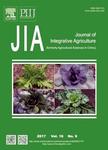Risk assessment and ranking of pesticide residues in Chinese pears
Risk assessment and ranking of pesticide residues in Chinese pears作者机构:Institute of PomologyChinese Academy of Agricultural Sciences/Laboratory of Quality & Safety Risk Assessment for Fruit (Xingcheng)Ministry of Agriculture Beijing Research Center for Agricultural Standards and Testing Zhengzhou Institute of PomologyChinese Academy of Agricultural Sciences Institute of Quality Standards & Testing Technology for Agro-ProductsXinjiang Academy of Agricultural Sciences Yantai Academy of Agricultural Sciences Northwest A&F University Institute of Tianjin Agriculture Quality Standard and Testing Technology
出 版 物:《Journal of Integrative Agriculture》 (农业科学学报(英文版))
年 卷 期:2015年第14卷第11期
页 面:2328-2339页
核心收录:
学科分类:09[农学] 090201[农学-果树学] 0710[理学-生物学] 0832[工学-食品科学与工程(可授工学、农学学位)] 090403[农学-农药学(可授农学、理学学位)] 0830[工学-环境科学与工程(可授工学、理学、农学学位)] 1004[医学-公共卫生与预防医学(可授医学、理学学位)] 0905[农学-畜牧学] 0906[农学-兽医学] 0904[农学-植物保护] 0901[农学-作物学] 0703[理学-化学] 0902[农学-园艺学] 0713[理学-生态学]
基 金:financially supported by the National Program for Quality and Safety Risk Assessment of Agricultural Products of China (GJFP2014002, GJFP2015002) the Core Research Budget of the Non-Profit Governmental Research Institution of China (0032014013)
主 题:pear pesticide residue risk assessment intake risk ranking
摘 要:The presence of pesticide residues in pears is a serious health concern. This study presents the results from a 2-year investigation (2013-2014) that used gas chromatography, GS/MS and UPLC/MS-MS to measure the levels of 104 pesti- cides in 310 pear samples. In 93.2% of the samples, 43 pesticides were detected, of which the maximum residue levels (MRLs) were exceeded in 2.6% of the samples. Multiple residues (two to eight compounds) were present in 69.7% of the samples; one sample contained nine pesticides and one sample contained 10. Only 6.8% of the samples did not contain residues. To assess the health risks, the pesticide residue data have been combined with daily pear consumption data for children and adult populations. A deterministic model was used to assess the chronic and acute exposures based on the Joint Meeting on Pesticide Residues (JMPR) method. A potential acute risk was demonstrated for children in the case of bifenthrin, which was found to be present at 105.36% of the acute reference dose (ARfD) value. The long- term exposure of the Chinese consumer to pesticide residues through the consumption of raw pears was far below the acceptable daily intake (ADI) criterion. Additionally, the matrix ranking scheme was used to classify risk subgroups of pesticides and pear samples. In general, 95.5% of samples were deemed to be safe and nine pesticides were classified as being of a relatively high risk. The findings indicated that the occurrence of pesticide residues in pears should not be considered a serious public health problem. Nevertheless, a more detailed study is required for vulnerable consumer groups, especially children. Continuous monitoring of pesticides in pears and tighter regulation of pesticide residue standards are recommended.



